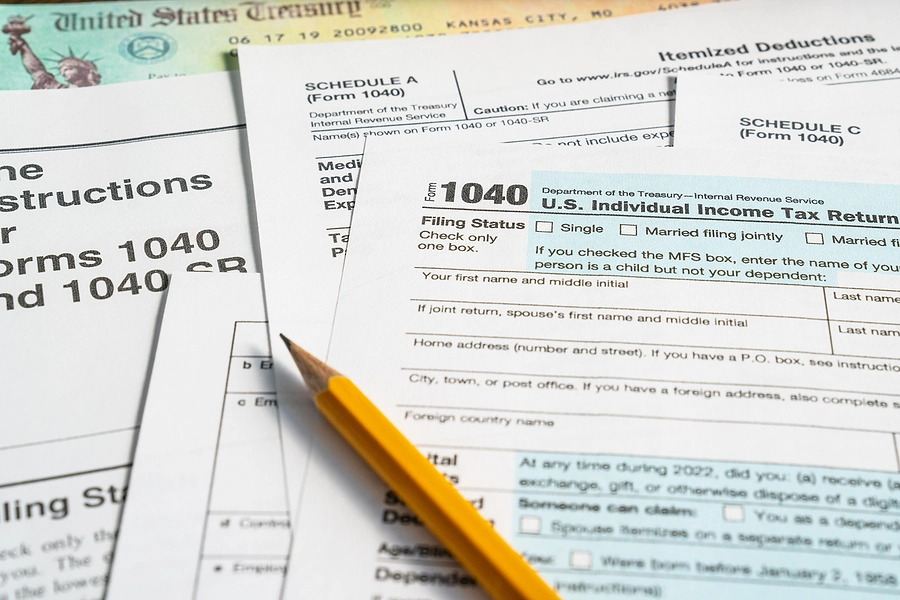Guide to Form 433-D

If you want to make monthly payments on your tax debt, you will eventually need to file Form 433-D. This relief form is only one page, but you need to complete it correctly. You should also ensure that you review the notes on the back as they outline the terms of your installment agreement.
Getting ready to set up an installment agreement? Then, here’s what you need to know about this form. Or call us directly to get help now.
What Is Form 433-D?
Form 433-D helps you set up monthly payments on your IRS tax debt. In some cases, you can use this form to apply for an installment agreement, but generally, you use 433-D to finalize an installment agreement after applying with another form.
Information on Form 433-D
Form 433-D requests the following information at the top of the form. If you’ve already been approved for an installment agreement, this part of the form may already be filled out by the IRS. Here’s what it covers:
- Your name and address
- Social Security Number or Employer Identification Number
- Phone number
- Type of taxes
- Tax periods
- Amount owed
- Downpayment if applicable
- Monthly payment
- If you want to increase or decrease the payment at any point
Once the above details are complete, you should initial that you agree to the terms of the agreement. The terms are on the back of Form 433-D, and they are also outlined later in this post.
How to Set Up Payments With Form 433-D
One of the main reasons that you use Form 433-D is to set up direct debits for your payment plan. If you want to pay automatically out of your bank account, just provide the routing and account number on this form. Note that in some cases, you may be required to set up direct debits if you owe over a certain amount.
If you don’t plan to pay through direct debit, follow the instructions on this form to mail in your payments. Every month, the IRS should mail you a payment voucher, but note that you must pay on time even if you don’t receive the voucher. Make your checks out to the United States Treasury, and write your Social Security Number or EIN on the check so the payments get credited correctly.
IRS Section on Form 433-D
At the bottom of Form 433-D, there is a section labeled “For IRS Use Only”. You don’t need to worry about this section, but if you’re wondering what it means, it has a few different elements.
There is one section where the IRS notes when to review your case. With most installment agreements, the IRS marks “no further review”. However, if you set up a partial payment installment agreement (PPIA), the IRS will review your case every two years.
This part of the form also has a section about federal tax liens. Depending on the situation, the IRS will note that a lien has already been filed, a lien will be filed, or a lien will only be filed if you default on the agreement. Whenever possible, you want the last option.
Form 9465 Vs. Form 433-D
Generally, you use Form 9465 (Installment Agreement Request) to apply for an installment agreement. Then, if the IRS accepts your application, you will finalize the agreement with Form 433-D.
However, in some cases, you can apply for an installment agreement using Form 433-D. For example, if you request an installment agreement over the phone, the IRS may send you Form 433-D to finalize the arrangements. Talk with a tax pro to learn the best move in your situation.
If you are planning to file a tax return and you want to set up payments on the debt, you can actually attach Form 9465 to your tax return. You cannot, however, attach Form 433-D to this form.
Requirements for IRS Installment Agreements
Once you set up an installment agreement, you must make your payments in full and on time. When you sign Form 433-D, you also agree to the following terms which are listed on the back of the form:
- To provide updated financial information to the IRS if requested.
- To allow the IRS to modify the agreement based on your updated financial information.
- To file all federal tax returns on time.
- to pay all federal tax bills on time.
- To let the IRS apply your refunds to your tax debt.
- To pay a reinstatement fee if you default on your agreement but the IRS lets you reinstate your agreement.
When you have an installment agreement, the IRS applies the payments to the oldest tax debts first. Note that if the IRS takes your tax refund, you still have to make the regular monthly payment that month.
Reasons the IRS Terminates Installment Agreements
Based on the instructions for 433-D, the IRS can terminate your agreement if any of the following things happen:
- You don’t pay on time — Usually, if you miss a payment, the IRS will send you a notice and give you a chance to catch up.
- You incur other federal tax debt — For example, you file a new tax return that you can’t afford to pay.
- The IRS believes that collection of the tax is in jeopardy — For example, the IRS believes that you’re going to flee the country and stop making payments.
If the IRS terminates your agreement, they will send you Notice CP523. Then, the agency will move forward with trying to seize your assets or garnish your wages. Except in the case of a jeopardy levy, the IRS must send you a notice before taking these types of actions.
Get Help With Form 433-D
Want help filing Form 433-D? Need assistance applying for a payment plan? Wondering if you should explore other options like an offer in compromise? Then, contact us today. At Seattle Legal Services, PLLC, we focus on helping people get out of tax debt. We can help you deal with the IRS, the WA DOR, and other state revenue agencies.
